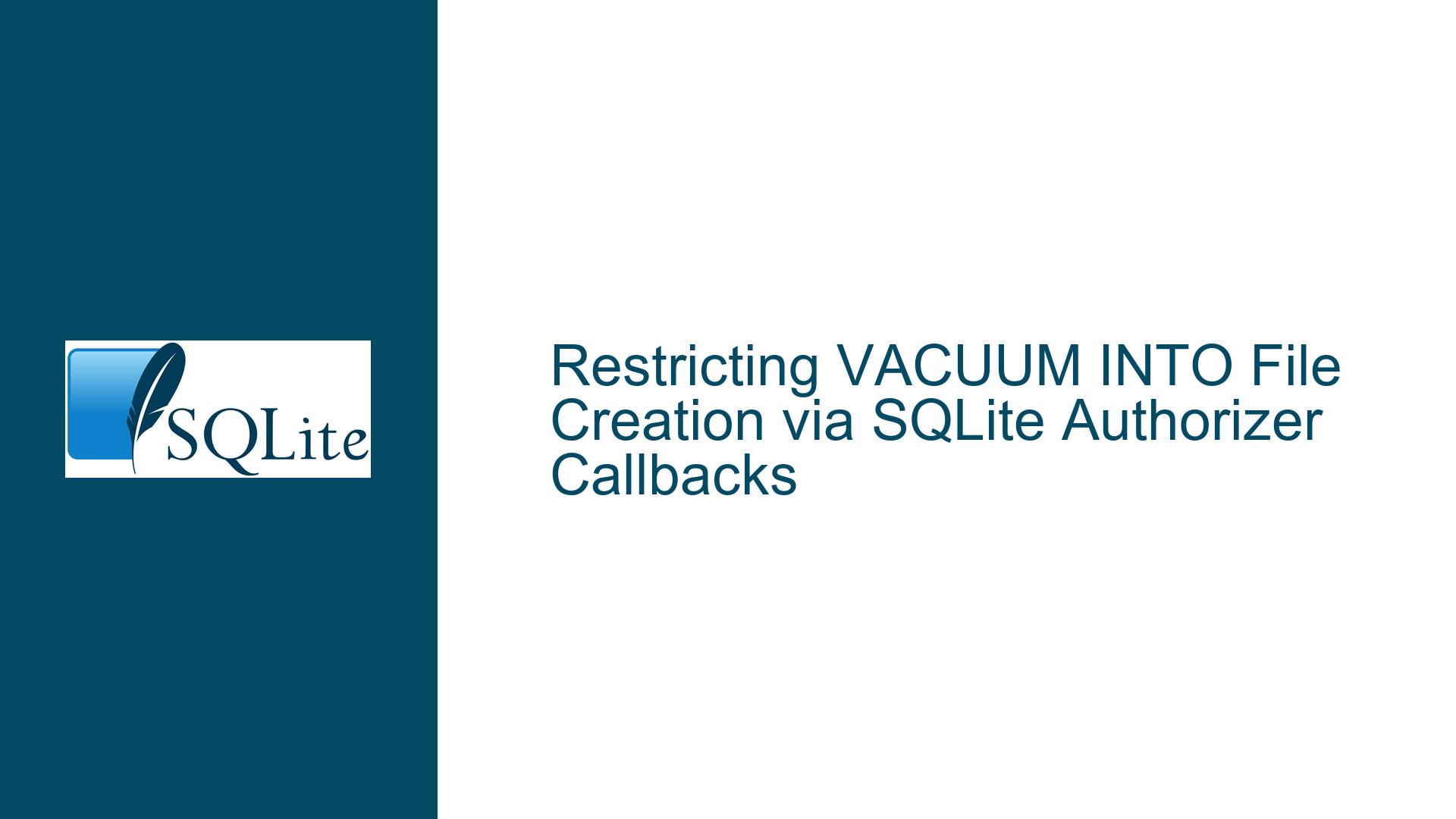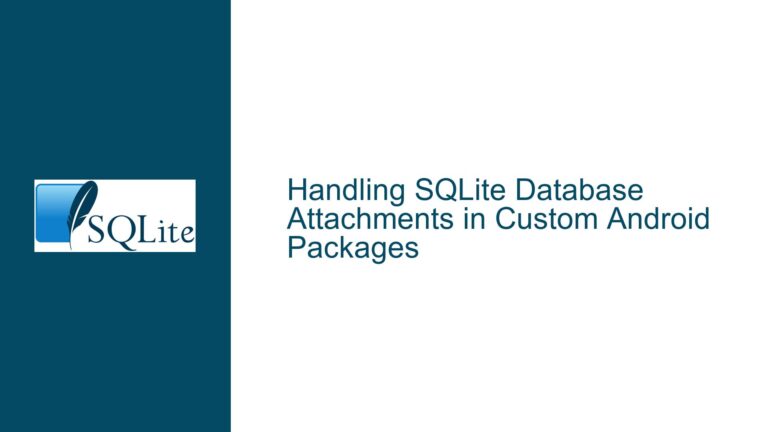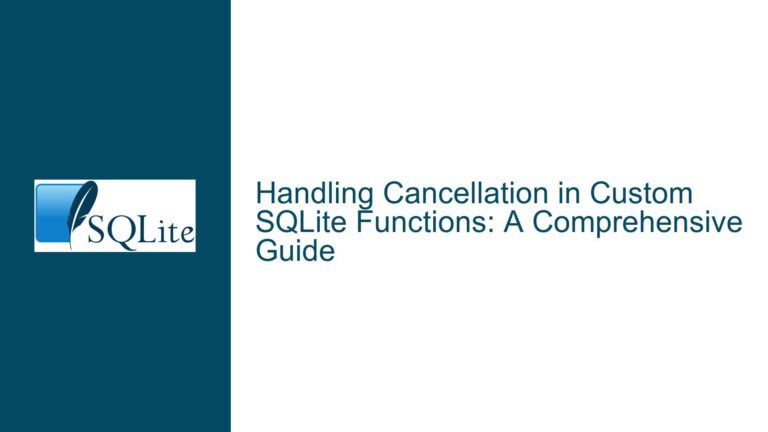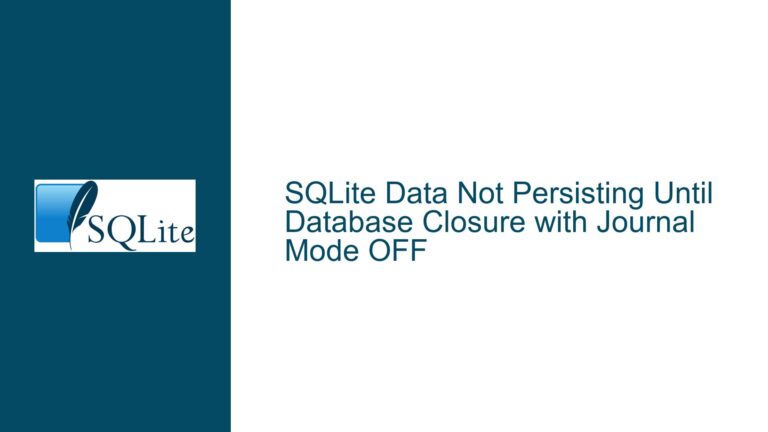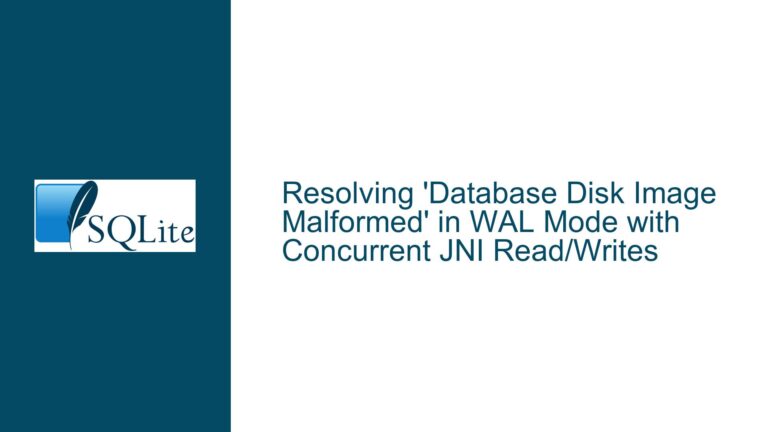Restricting VACUUM INTO File Creation via SQLite Authorizer Callbacks
Interplay Between VACUUM INTO, ATTACH Operations, and Authorization Policies
The challenge of controlling where SQLite writes files during VACUUM INTO operations stems from the command’s reliance on internal database attachment mechanisms. Unlike direct file system writes controlled through standard SQL statements, VACUUM INTO 'filename' operates through a multi-step process that combines schema replication and data transfer via an implicitly attached secondary database. This behavior creates security considerations when applications need to restrict file creation paths while allowing legitimate maintenance operations.
At its core, VACUUM INTO functions as a macro command that automates the creation of a temporary attached database, schema cloning, data copying, and cleanup. The SQLite engine does not expose granular control over the individual steps of this process through standard SQL syntax. Instead, the operation’s security surface ties directly to the ATTACH command’s authorization checks. When a user attempts to execute VACUUM INTO '/path/to/file.db', SQLite first validates whether attaching a database at the specified path is permitted under the current authorization rules. Blocking the initial ATTACH operation effectively neutralizes the entire VACUUM INTO command, as the subsequent steps depend on the successful creation of the target database file.
The critical dependency between VACUUM INTO and ATTACH authorization creates both opportunities and challenges for developers. While SQLite’s sqlite3_set_authorizer() interface provides a mechanism to intercept and approve/reject database operations, its effectiveness hinges on correctly identifying the context in which ATTACH is invoked. Applications must distinguish between attachment requests originating from user-supplied SQL and those triggered internally by maintenance commands like VACUUM INTO. Failure to implement path validation logic within the authorizer callback can lead to false positives (blocking legitimate attachments) or false negatives (allowing unauthorized file creation).
Inadequate ATTACH Command Filtering and VACUUM INTO’s Implicit File Creation
The primary vulnerability enabling unauthorized file creation through VACUUM INTO lies in insufficient validation of attachment paths during the authorization phase. SQLite’s default behavior permits attaching databases at any file system location writable by the process, unless explicitly restricted. When applications fail to implement an authorizer callback or implement one that does not scrutinize ATTACH operations, malicious actors can exploit VACUUM INTO to write database files to arbitrary directories. This risk escalates in environments where SQLite operates with broad file system permissions or when handling untrusted SQL input.
Another contributing factor is the layered execution structure of VACUUM INTO. The command’s implementation involves generating transient SQL statements (CREATE TABLE, INSERT, etc.) targeting the attached backup database. These statements may bypass coarse-grained authorization policies that focus solely on blocking explicit VACUUM commands without considering the underlying ATTACH requirement. Developers might mistakenly assume that disabling the SQLITE_VACUUM action code in the authorizer suffices to block VACUUM INTO, but this approach fails because the critical security gate occurs earlier during the attachment phase.
Misconfiguration of the authorizer callback’s return codes further exacerbates the problem. The SQLITE_DENY response code terminates the entire SQL statement and rolls back any associated transactions, while SQLITE_IGNORE causes the operation to proceed as if the user had no privileges for that action. Applying SQLITE_IGNORE to ATTACH operations instead of SQLITE_DENY could lead to incomplete blocking, allowing VACUUM INTO to proceed under certain conditions. Similarly, overlooking the need to handle SQLITE_ATTACH action codes specifically (as opposed to relying on general policy enforcement) leaves a gap in the defense mechanism.
Implementing Path Validation and ATTACH Restrictions via sqlite3_set_authorizer()
To securely restrict VACUUM INTO file creation, developers must deploy an authorization callback that intercepts and validates ATTACH operations. The following steps outline a comprehensive strategy:
Step 1: Initialize the Authorizer Callback
Register a custom authorization function using sqlite3_set_authorizer(db, auth_callback, user_data), where db is the database connection handle. The callback function will receive detailed parameters about each attempted operation, including the database name for ATTACH commands.
Step 2: Intercept ATTACH Operations
Within the authorization callback, check for the SQLITE_ATTACH action code. This code signals that SQLite is attempting to attach a database file. Extract the filename from the third parameter (const char *P3), which contains the path argument from the ATTACH statement.
Step 3: Validate the Target File Path
Implement logic to validate whether the extracted file path complies with application security policies. For example, restrict attachments to a specific directory:
int auth_callback(void *user_data, int action_code, const char *P1, const char *P2, const char *P3, const char *P4) {
if (action_code == SQLITE_ATTACH) {
const char *allowed_path = "/secure/backup/directory/";
if (strncmp(P3, allowed_path, strlen(allowed_path)) != 0) {
return SQLITE_DENY;
}
}
return SQLITE_OK;
}
This code denies any ATTACH operation where the target path does not start with the predefined secure directory.
Step 4: Handle Schema Name Collisions
The second parameter (const char *P2) in the SQLITE_ATTACH action provides the schema name for the attached database. While VACUUM INTO uses temporary schema names, applications should also validate or restrict these names to prevent conflicts with existing attached databases, which could lead to unexpected behavior even if the file path is authorized.
Step 5: Test with VACUUM INTO and Direct ATTACH Commands
Verify the authorizer’s effectiveness by attempting both VACUUM INTO '/unauthorized/path.db' and direct ATTACH '/unauthorized/path.db' AS x statements. The callback should block both, returning SQLITE_AUTH errors. Ensure that legitimate ATTACH operations within the allowed directory succeed when initiated outside VACUUM INTO, if required by the application.
Step 6: Combine with Other Authorization Policies
Supplement ATTACH restrictions with broader authorization rules. For example, deny SQLITE_CREATE_TABLE operations on the main schema to prevent schema modifications, while allowing them on temporary or backup schemas. This layered approach minimizes the impact of a misconfigured ATTACH policy.
Advanced Consideration: Dynamic Allow Lists
For applications requiring flexible path restrictions, implement dynamic allow lists stored in the user_data pointer. Encode permitted directories or patterns in a structure accessible to the callback, enabling runtime updates without recompilation. Use thread-safe data structures if the authorizer operates in multi-threaded environments.
Debugging Authorization Failures
If VACUUM INTO unexpectedly succeeds despite the authorizer, enable SQLite’s error logging and check whether the SQLITE_ATTACH action is being triggered and properly evaluated. Trace logs can reveal discrepancies between the expected and actual file paths, highlighting issues with relative path resolution or string comparison logic.
Alternative Approach: Compile-Time Options
For environments where runtime authorization is insufficient, consider recompiling SQLite with the -DSQLITE_DEFAULT_NO_ATTACH=1 option, which disables ATTACH commands unless explicitly enabled. This nuclear option may be unsuitable for applications requiring legitimate attachment capabilities but offers a fallback for high-security contexts.
Final Validation
After implementing the authorizer, conduct penetration testing to simulate attacks attempting to write VACUUM INTO files outside permitted directories. Use tools like strace (Linux) or Process Monitor (Windows) to confirm that SQLite does not attempt to open or create files in unauthorized locations. Periodically audit the callback logic to align with evolving file system permissions and application requirements.
